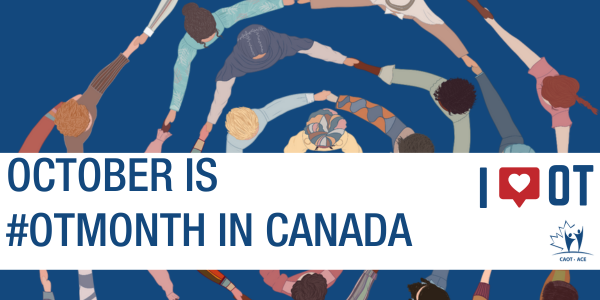Welcoming Theo Ortega to OT Works!
We are thrilled to introduce Theo Ortega, the newest member of the OT Works! team. Joining us in January 2025, Theo brings a wealth of experience, cultural insight, and dedication to helping clients regain their independence and engage in the activities that matter most.
Theo is passionate about delivering personalized care and fostering collaboration with clients. His approach focuses on empowering individuals to overcome challenges and rediscover their confidence.
Having traveled extensively across North and South America, Europe, and Asia, Theo has cultivated a deep cultural awareness that informs his ability to tailor his support to each client’s unique needs. He has worked with diverse populations in Canada, the United States, and the Netherlands, focusing on a wide range of conditions, including:
- Musculoskeletal and orthopedic injuries
- Oncology-related conditions
- Chronic pain
- Concussions and traumatic brain injuries
- Complex diagnoses
Theo spent much of his career practicing in Toronto, Ontario, before expanding his practice to the United States, where he focused on oncology rehabilitation and lymphedema therapy in Orlando, Florida. Additionally, his service in the Canadian Armed Forces gives him a distinctive perspective on the needs of military personnel and veterans.
Based in Victoria, Theo offers services to clients through WorkSafeBC, ICBC, private insurance, and self-pay. He is a registered member of the College of Health and Care Professionals of BC.
We are excited to have Theo join OT Works! and are confident that his skills and passion will benefit our clients and community!
Based in Victoria, Theo offers services to clients through WorkSafeBC, ICBC, private insurance, and self-pay. He is a registered member of the College of Health and Care Professionals of BC.
We are excited to have Theo join OT Works! and are confident that his skills and passion will benefit our clients and community!
Get started with an OT
If you or someone you know can benefit from the support of an occupational therapist, reach out to us today!
Email: referrals@ot-works.com
Phone: 604.696.1066 ext. 1000.
OT Works! Holiday Hours
OT Works! will be closed during the holidays.
We will be back to our regular hours on January 02, 2025, when we will be accepting new clients in Vancouver, Metro Vancouver, Fraser Valley, Sea-to-Sky, Victoria, Nanaimo, and the Comox Valley.
| Monday, December 23, 2024 | Open, 9am-5pm |
| Tuesday, December 24, 2024 | Open, 9am-12pm |
| Wednesday, December 25, 2024 | Closed |
| Thursday, December 26, 2024 | Closed |
| Friday, December 27, 2024 | Closed |
| Monday, December 30, 2024 | Closed |
| Tuesday, December 31, 2024 | Closed |
| Wednesday, January 01, 2025 | Closed |
| Thursday, January 02, 2025 | Open, 9am-5pm |
| Friday, January 03, 2025 | Open, 9am-5pm |
Regular business hours resume on January 02.
We wish you a very Happy Holidays and a Joyous New Year!
Get started with an OT
Our therapists at OT Works! are registered and in good standing with the College of Occupational Therapists of British Columbia (COTBC). Our approach is based on current research and evidence-based practice.
If you or someone you know could benefit from occupational therapy, contact us today!
Email: referrals@ot-works.com
Vancouver: 604.696.1066
Victoria: 250.999.8896
Meet Japneet Brar: Occupational Therapist
We’re excited to introduce Japneet Brar, MScOT, to OT Works!
Japneet joined us in July 2024 and brings a strong academic background and diverse clinical experience.
She earned her Master of Science in Occupational Therapy from the University of Toronto in 2022 and holds a Bachelor’s degree in Cognitive Systems from the University of British Columbia.
Japneet has worked in various settings, including acute care, community outreach, and clinics, where she has supported clients with conditions such as traumatic brain injuries, orthopedic injuries, chronic pain, and more.
Japneet offers her services to clients across the Fraser Valley, including Abbotsford, Chilliwack, Surrey, and Langley. She works with individuals covered by WSBC, ICBC, private insurance, and self-paying clients. Japneet is a registered member of the College of Health and Care Professionals of BC (CHCPBC).
We’re excited to have Japneet on board and look forward to the valuable contributions she’ll make.
Get started with an OT
If you or someone you know can benefit from the support of an occupational therapist, reach out to us today!
Email: referrals@ot-works.com
Phone: 604.696.1066 ext. 1000.
Meet Katy Lovick: Occupational Therapist
We’re pleased to welcome Katy Lovick, new occupational therapist, to OT Works!
Katy joined OT Works! in January 2024. She brings with her a wealth of experience in helping clients with various diagnoses, such as brain injuries, neurological conditions, physical injuries, amputations, and mixed diagnoses.
Katy holds a master’s degree in occupational therapy from Glasgow Caledonian University, and a Bachelor of Sport & Fitness Leadership – specialization in exercise and wellness, from Camosun College.
Katy is passionate about the versatility of occupational therapy and has worked in both private and public health sectors. She embraces a client-centered approach, recognizing that everyone has unique strengths and challenges on their path to recovery. Katy has successfully supported clients in meaningful activities, including daily living tasks, returning to work, and engaging with their communities. She brings professionalism, experience, and a commitment to excellence to every client interaction.
In her spare time, Katy enjoys all the nature that Vancouver Island has to offer, travelling and getting active.
Katy serves a diverse clientele, including individuals covered by WSBC, ICBC, private-paying clients, and those with extended health/disability insurance. She provides her services across South Vancouver Island, including Victoria, Langford, Saanich, and Sidney.
Katy is a full registrant and in good standing with the College of Occupational Therapists of British Columbia (COTBC).
We’re thrilled to have her on board and look forward to the positive impact she’ll make in our community.
Get started with an OT
If you would like Katy’s help with your recovery or if someone you know could benefit from occupational therapy, contact us today!
Email: referrals@ot-works.com
Phone: 604.696.1066 ext. 1000.
Start Occupational Therapy after a car accident
Get help. Get better. Get well.
Ask for OT for your ICBC claim.

You have been injured in a car accident, and you have not fully recovered. You want to get back to your regular life, but you are not sure how or where to get started. Ask for Occupational Therapy (OT) for your ICBC claim.
Occupational Therapy is fully covered by ICBC.
Occupational therapy can help you put the pieces together that you need to get better. OTs provide individualized care that is specific to you, your injuries, and your life. They listen to you and focus their work on your goals and what is meaningful to you.
We can help you to get back to living your life after a car accident.
How OT can help after an accident
An Occupational Therapist can help you in many ways after a car accident.
We focus on your function and help you perform a wide variety of activities. Whether you’re having physical, cognitive, and emotional difficulties, an OT can help. We see each person as unique and tailor our approach to you.
An Occupational Therapist can help you with activities like:
- Preparing you and your home for your discharge from hospital
- Restoring basic activities, like bathing, dressing, grooming and personal hygiene
- Getting you back to activities like home making, finances, meal planning, community access
- Leisure and recreation
- Getting back to school or work
- Return to driving
Click here to learn how an OT can assist you in different stages of your recovery.
OT is fully covered by ICBC
Occupational therapy is covered under ICBC’s Enhanced Care model. There are no user-fees for OT.
However, OT is not pre-approved like other health professions. To have an OT help your recover, your ICBC claims specialist must approve OT involvement. To get approval, you will need a referral from your GP or a doctor’s note. Talk to your doctor if an OT would be right for you.
If ICBC has already approved funding for Occupational Therapy for you, simply email us the written authorization, and we will assign an OT to assist you.
ICBC must approve OT services before you start with an OT.
Get Started with an OT
After reporting a claim to ICBC, you can ask your ICBC Recovery Specialist for OT. You can also contact our Referrals Team at OT Works! to discuss your situation. You can reach us by phone, email or on our website:
- By phone, at (604)696-1066
- By email, at referrals@ot-works.com
- By sending the referral form to us by email or fax
You need a GP referral (or Doctor’s note) for ICBC to pay for OT services.
What do I need to get started?
You will need to provide some personal information, ICBC claim details, and a GP note.
Your GP note should state the reason for referral and how it’s related to the MVA.
Our Referrals Team will then guide you through the process.
If you are not sure if OT has been approved, our Referrals team will contact ICBC and/or your legal counsel on your behalf to secure funding.
How much does OT cost?
If ICBC has approved OT services for you, our OT services will be fully paid by ICBC. There are no user fees and you don’t have to pay anything out of pocket.
NOTE: ICBC will not pay for OT services that have not been approved. We recommend always getting ICBC approval before starting with an OT. If you are not sure how to get the approval, give us a call and we can help
When can I start working with an OT?
It depends, but our goal is to make the whole process as fast as possible. We always try to assign the best OT that matches your situation and find the right fit for you. It may take some time for the right OT to become available. Our Referrals team will keep you informed during the process and inform you of any wait times.
Who will contact ICBC to get approval for Occupational Therapy?
Our Referrals team and/or your legal counsel will contact ICBC on your behalf to get approval for OT.
Where are OT services delivered?
Our OTs work in the community, and can see you in your home, workplace or in a community setting (park, community center).
We can also offer telehealth if that’s appropriate for your situation.
OT Works! has OTs available in the following areas:
- Lower Mainland: Vancouver, Burnaby, New Westminster, Surrey, North & West Vancouver, Richmond, Delta, Port Moody, Coquitlam, Port Coquitlam, Langley, Maple Ridge, Pitt Meadows
- Fraser Valley: Mission, Abbotsford, Chilliwack
- Sea-to-Sky: Squamish, Whistler, Pemberton
- Sunshine Coast: Gibsons, Sechelt
- Vancouver Island:
- South: Victoria, Esquimalt, Sooke, East Sooke, Saanich, Sidney, Langford, Colwood, Metchosin
- Central: Nanaimo, Parksville, Ladysmith, Qualicum Beach, Port Alberni
- North: Campbell River, Courtney, Comox, Cumberland, Fanny Bay, Nanoose Bay, Union Bay
Are all of your OTs approved by ICBC?
All our OT’s are authorized by ICBC to provide OT services. Occupational Therapists s are university-educated professionals, registered by the College of Occupational Therapists of BC.
Get started today
Ask for OT!
If you are ready to start your rehabilitation after a car accident, ask for OT and contact us today.
Our OTs will be happy to help you getting back to the life you love!
Photo by Daniel Xavier from Pexels
Meet Heidi Nygard: Occupational Therapist
We’re excited to announce the newest addition to our team, Heidi Nygard, a dedicated occupational therapist at OT Works!
Since joining us in August 2023, Heidi has been instrumental in delivering exceptional community-based OT services, focusing on enhancing individual independence and helping clients achieve their goals through tailored daily activities at home, work, and within their communities.
Heidi holds a master’s degree in occupational therapy from UBC, bringing knowledge to support individuals with learning disabilities and leveraging assistive technology within her clinical practice.
With experience spanning diverse populations in return-to-work, post-secondary, and community home health settings, Heidi has assisted clients dealing with various challenges, including mental health conditions, chronic pain, concussion/traumatic brain injury, and complex diagnoses, guiding them toward achieving their meaningful and purposeful goals.
Before embarking on her journey as an OT, Heidi contributed her skills to various roles, including serving as a Case Manager in a community employment program, working as a library technician in a Braille library, and acting as a learning strategist/assistive technologist for students with disabilities at UBC.
Heidi caters to a diverse clientele, encompassing individuals covered by WSBC, ICBC, private-paying clients, and those with extended health/disability insurance. She serves clients in the Central Vancouver Island area, including Ladysmith, Duncan, and Nanaimo.
Heidi is a full registrant and in good standing with the College of Occupational Therapists of British Columbia (COTBC).
Get started with an OT
If you or someone you know can benefit from the expertise and support of an occupational therapist, reach out to us today!
Email: referrals@ot-works.com
Phone: 604.696.1066 ext. 1000.
Join us in celebrating Occupational Therapy: October is OT Month!
Every October, OT Works! takes pride in celebrating our exceptional team of Occupational Therapists and the impact they have on the lives of our clients.
Unity Through Community
OT month is celebrated both locally and internationally, with October 27th being recognized as World Occupational Therapy Day. This year, we are inspired by the theme proposed by The World Federation of Occupational Therapists (WFOT): “Unity Through Community.”
Occupational Therapists play a crucial role in facilitating their clients’ recovery and well-being by fostering collaboration with other healthcare professionals. This collaborative approach ensures that our clients receive the holistic and comprehensive care they deserve.
“To have real impact, and truly make a difference in our clients’ lives, we must work together. Every discipline brings different tools and perspectives, and when we coordinate our efforts and focus on the client’s goals, meaningful change happens.”
Pamela Russell, Clinical Director, OT Works!
Lighting up the country for World OT Day

To raise awareness about the field of occupational therapy and to acknowledge the contributions made by OTs since the inception of the profession in 1926, landmarks across Canada will be illuminated in blue on October 27th, celebrating World OT Day.
In BC, the BC Place Stadium and the Science World in Vancouver will be bathed in blue light to celebrate OT Day!
Occupational Therapy at OT Works!
AT OT Works!, our team of dedicated therapists is certified by the College of Occupational Therapists of British Columbia (COTBC). They are skilled in treating clients with a wide range of needs, including physical injuries, mental health conditions, and brain injuries.
Our Occupational Therapists serve communities across the Lower Mainland, Fraser Valley, Sea-to-Sky, and Vancouver Island. To learn more about our services, contact us.
Learn more
As we celebrate OT Month and World OT Day, we invite you to explore further resources and insights about occupational therapy through the following links:
Canadian Association of Occupational Therapy (CAOT)
World Federation of Occupational Therapy
Join us in recognizing the incredible impact of Occupational Therapists, and for being a part of our mission to empower individuals in their pursuit of a better quality of life.
Happy OT Month!
Empowering Veterans: OT Works! Supports Veterans and RCMP Service Members on Their Journey to Post-Service Life
At OT Works!, we take pride in being able to serve our veterans through Veterans Affairs Canada (VAC). Our Occupational Therapists (OTs) can play a large role in guiding service members as they transition back into civilian life. We understand that this journey can be challenging, and that’s why we create personalized treatment plans to assist our clients in enhancing their daily life management.
As experts in functional rehabilitation, our OTs understand the difficulties that veterans and their families may face during this transition period. Our therapists build upon the service member’s existing skills, fostering efficiency, safety, and independence.
Under contract with VAC, OT Works! therapists provide Occupational Therapy assessments and treatment. These interventions encompass a wide spectrum, including:
- home adaptations
- assistive device prescriptions (including wheelchairs and scooters)
- mental health support
- managing disrupted routines, and
- tackling occupational challenges arising from traumatic brain injuries.
How Can an OT Help?
Our commitment is to provide personalized and effective treatment not only to veterans but also to their families. As community-based occupational therapists, we meet our clients in their environments, whether it’s their workplaces, schools, gyms, homes, or communities.
We value the rich diversity of experiences our clients bring to the table and have established a rigorous Quality Assurance process to ensure they receive the care they truly deserve. OT Works! takes pride in helping our veterans become the best version of themselves.
We extend our support to those with physical injuries, such as soft tissue injuries, orthopedic conditions, and brain injuries, as well as those dealing with trauma-induced or exacerbated mental health conditions like PTSD, depression, and anxiety. Additionally, our clinical expertise extends to chronic pain and operational stress injuries.
Services we offer
Our Occupational Therapists employ evidence-based, trauma-informed care strategies. We place a strong emphasis on compensation and goal-oriented treatment plans, assisting clients by:
- Providing educational insights into injuries, current abilities, and recovery, such as pain management and typical recovery timelines.
- Working to enhance and expand current abilities or skills, whether it’s increasing lifting tolerance or improving emotional regulation.
- Adapting materials and environments, from adding a bench in the shower to assessing the need for a power wheelchair.
- Recommending environmental changes, including connecting clients with specialized public transportation options or advocating for workplace accommodations.
Our Experience with VAC Clients
Our OTs are passionate about working with veterans and boast extensive experience in addressing their unique needs. Some of our team members have been dedicated to serving veterans for many years. We understand the distinctive challenges and requirements of veterans, thanks in part to our Clinical Director, Pamela Russell, who grew up in a military family. Her father served as a military member, with her mother supporting veterans through a career with Veterans Affairs Canada. This understanding of both military and civilian life ensures our client-centered services celebrate your strengths and competencies, ultimately helping you manage everyday tasks efficiently, safely, and as independently as possible.
Areas served
Our services extend across various regions, including:
- Metro Vancouver: Vancouver, Burnaby, New Westminster, Surrey, North & West Vancouver, Richmond, Delta, White Rock, Port Moody, Coquitlam, Port Coquitlam, Langley, Fort Langley, Maple Ridge, Pitt Meadows.
- Fraser Valley: Mission, Abbotsford, Chilliwack, Harrison Lake, Agassiz, Dewdney, Hope.
- Sea-to-Sky: Squamish, Whistler, Pemberton.
- Vancouver Island-South: Victoria, Esquimalt, Sooke, East Sooke, Saanich, Sidney, Langford, Colwood, Metchosin.
- Central Island: Ladysmith, Nanaimo, Parksville, Qualicum Beach, Port Alberni.
- North Island: Campbell River, Courtney, Comox, Cumberland, Fanny Bay, Nanoose Bay, Union Bay.
Referring a Veteran
Referring a veteran to OT Works! is a straightforward process:
- VAC Case Managers: Send your referral through the BHSOL portal.
- RCMP Case Managers: Feel free to send the referral to us via email, fax, or give us a call to discuss.
- Veterans: If you’re a veteran unsure of your needs, please discuss them with your Case Manager. If you have any questions or uncertainties, don’t hesitate to contact us, and we’ll be more than happy to assist you.
Get started with an OT
If you or someone you know could benefit from the guidance of a skilled occupational therapist, we invite you to reach out to us today:
Email: referrals@ot-works.com
Phone: 604.696.1066 ext. 1000.
At OT Works!, we are dedicated to supporting veterans as they embark on their post-service journeys towards a fulfilling and independent life.
Introducing Karen, Parisa, and Simone: Occupational Therapists
We are thrilled to present the latest additions to our dynamic team: Karen Gill, Parisa Madani, and Simone Mann – occupational therapists at OT Works!
Since joining us between May and July of 2023, they have been delivering exceptional community-based occupational therapy services. Through their dedicated efforts to incorporate daily routines at home, work, and within the community, they are committed to enhancing independence and guiding clients towards their rehabilitation goals.
Karen earned her Master of Occupational Therapy at McMaster University. She is an advocate for a client-centered approach, aiming to empower individuals to engage in meaningful activities encompassing personal care, employment, and leisure pursuits. Karen has successfully assisted clients navigating challenges related to concussion, traumatic brain injury, chronic pain, and mental health concerns such as anxiety and depression. Her knowledge extends to musculoskeletal and orthopedic injuries, as well as mixed diagnoses. Karen extends her support to a diverse clientele, including those with WSBC and ICBC claims, private-paying clients, and individuals with extended health and disability insurance coverage. Fluent in Punjabi and Hindi, Karen serves the Surrey/Langley area.
Parisa, a graduate of the University of British Columbia’s Master of Occupational Therapy program, enriches our team with her valuable background as a Kinesiologist. Her prior experience underscores the significance of active physical therapy for sustainable outcomes. Parisa specializes in aiding clients grappling with musculoskeletal and orthopedic injuries, chronic pain, and mental health challenges on their journey back to the workforce. She extends her guidance to individuals within WSBC, ICBC, private-pay sectors, and those covered by extended health and disability insurance plans. Fluent in Spanish, Parisa serves communities in Surrey, Langley, Burnaby, and New Westminster.
Simone is a dedicated occupational therapist who achieved her Master of Occupational Therapy at Bond University in Australia. She stands out for her compassionate and respectful demeanor, which she combines with innovative, evidence-based interventions tailored to each client’s distinct values and needs. Simone excels in supporting clients dealing with physical injuries, chronic pain management, exposure therapy, and brain injury rehabilitation. With a clientele encompassing WSBC and ICBC claims, private-paying individuals, and those under extended health and disability insurance, Simone brings her expertise to the fore. Fluent in Punjabi and Hindi, she serves clients in Delta, Surrey, Langley, Richmond, New Westminster, and Burnaby.
All our therapists, including Karen, Parisa and Simone, are registrants and in good standing with the College of Occupational Therapists of British Columbia (COTBC).
Get started with an OT
If you or someone you know can benefit from the guidance of a skilled occupational therapist, we invite you to contact us today!
Email: referrals@ot-works.com
Phone: 604.696.1066 ext. 1000.
Meet Micaylee, Yasmine, and Brenden: Occupational Therapists
We’re excited to introduce the newest members of our team, Micaylee Pucilowski, Yasmine Mackie, and Brenden James, occupational therapists at OT Works!
They joined our team in February-March 2023, and have since been providing exceptional community OT services to individuals. By implementing daily activities at home, work, and in the community, they work to foster increased independence and help clients achieve their goals.
Micaylee completed her Master of Occupational Therapy at Western University and has a passion for making a meaningful difference in her clients’ lives. She has experience working with musculoskeletal/orthopaedic injuries, chronic pain, mental health (anxiety/depression), and concussion/traumatic brain injury. Micaylee works with a range of clients, including those with WSBC, ICBC, private-paying clients, and those with extended health/disability insurance. She serves clients in the Metro Vancouver region.
Yasmine completed her Master of Science in Neuroscience and her Master of Science in Occupational Therapy at the University of Alberta. She is passionate about supporting clients in their recovery through collaboration and engagement in meaningful activities. She has experience working with individuals with musculoskeletal/orthopaedic injuries, chronic pain, mental health concerns (including, but not limited to, anxiety, depression, and PTSD), concussion/traumatic brain injury, and mixed diagnoses. Yasmine works with WSBC, ICBC, private paying clients, and those with extended health/disability insurance. She serves clients in the Tri-Cities, Surrey, Burnaby, and New Westminster.
Brenden completed his Master’s degree in Occupational Therapy from the University of British Columbia and his undergraduate degree in Kinesiology from McGill University. He has honed his skills in mental health, chronic pain, and mixed diagnoses throughout his academic and professional career. Brenden works with a range of clients, including those with WSBC, ICBC, private-paying clients, and those with extended health/disability insurance. He serves clients in the Metro Vancouver region.
All our therapists, including Micaylee, Yasmine, and Brenden, are full registrants and in good standing with the College of Occupational Therapists of British Columbia (COTBC).
Get started with an OT
If you or someone you know could benefit from working with an occupational therapist, contact us today!
Email: referrals@ot-works.com
Phone: 604.696.1066 ext. 1000.










